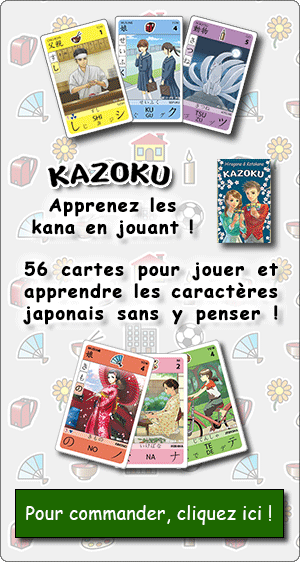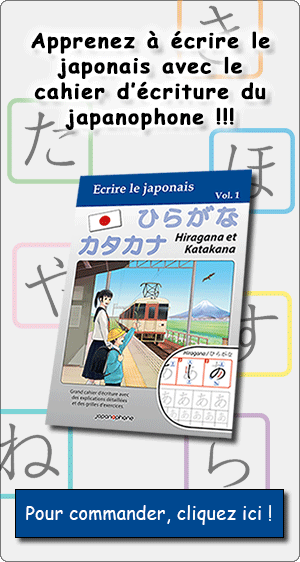Japanese names
Japanese names
Click on a letter to display the corresponding list.
| Japanese Name | Hiragana | Phonetics |
| Fū | ふう | [ɸɯː] |
| Fubuki | ふぶき | [ɸɯbɯki] |
| Fudeko | ふでこ | [ɸɯdeko] |
| Fueko | ふえこ | [ɸɯeko] |
| Fufu | ふふ | [ɸɯɸɯ] |
| Fugaku | ふがく | [ɸɯgakɯ] |
| Fujie | ふじえ | [ɸɯdʑie] |
| Fujihiko | ふじひこ | [ɸɯdʑiçiko] |
| Fujiichirō | ふじいちろう | [ɸɯdʑiːtɕiɽoː] |
| Fujiko | ふじこ | [ɸɯdʑiko] |
| Fujimi | ふじみ | [ɸɯdʑimi] |
| Fujino | ふじの | [ɸɯdʑino] |
| Fujio | ふじお | [ɸɯdʑio] |
| Fujitaka | ふじたか | [ɸɯdʑitaka] |
| Fujiyo | ふじよ | [ɸɯdʑijo] |
| Fuka | ふか | [ɸɯka] |
| Fukami | ふかみ | [ɸɯkami] |
| Fuki | ふき | [ɸɯki] |
| Fukie | ふきえ | [ɸɯkie] |
| Fukiko | ふきこ | [ɸɯkiko] |
| Fūko | ふうこ | [ɸɯːko] |
| Fuku | ふく | [ɸɯkɯ] |
| Fukujirō | ふくじろう | [ɸɯkɯdʑiɽoː] |
| Fukuko | ふくこ | [ɸɯkɯko] |
| Fukumi | ふくみ | [ɸɯkɯmi] |
| Fukuno | ふくの | [ɸɯkɯno] |
| Fukuo | ふくお | [ɸɯkɯo] |
| Fukuto | ふくと | [ɸɯkɯto] |
| Fukuyo | ふくよ | [ɸɯkɯjo] |
| Fūma | ふうま | [ɸɯːma] |
| Fumi | ふみ | [ɸɯmi] |
| Fumiaki | ふみあき | [ɸɯmiaki] |
| Fumie | ふみえ | [ɸɯmie] |
| Fumiharu | ふみはる | [ɸɯmihaɽɯ] |
| Fumihiko | ふみひこ | [ɸɯmiçiko] |
| Fumihiro | ふみひろ | [ɸɯmiçiɽo] |
| Fumihito | ふみひと | [ɸɯmiçito] |
| Fumiichirō | ふみいちろう | [ɸɯmiːtɕiɽoː] |
| Fumijirō | ふみじろう | [ɸɯmidʑiɽoː] |
| Fumika | ふみか | [ɸɯmika] |
| Fumikazu | ふみかず | [ɸɯmikazɯ] |
| Fumiko | ふみこ | [ɸɯmiko] |
| Fumimaro | ふみまろ | [ɸɯmimaɽo] |
| Fumina | ふみな | [ɸɯmina] |
| Fumino | ふみの | [ɸɯmino] |
| Fuminori | ふみのり | [ɸɯminoɽi] |
| Fumio | ふみお | [ɸɯmio] |
| Fumitaka | ふみたか | [ɸɯmitaka] |
| Fumiya | ふみや | [ɸɯmija] |
| Fumiyo | ふみよ | [ɸɯmijo] |
| Funa | ふな | [ɸɯna] |
| Fune | ふね | [ɸɯne] |
| Fusa | ふさ | [ɸɯsa] |
| Fusae | ふさえ | [ɸɯsae] |
| Fusaichirō | ふさいちろう | [ɸɯsaitɕiɽoː] |
| Fusajirō | ふさじろう | [ɸɯsadʑiɽoː] |
| Fusako | ふさこ | [ɸɯsako] |
| Fusanori | ふさのり | [ɸɯsanoɽi] |
| Fusayo | ふさよ | [ɸɯsajo] |
| Fusayoshi | ふさよし | [ɸɯsajoɕi] |
| Fusazō | ふさぞう | [ɸɯsazoː] |
| Futaba | ふたば | [ɸɯtaba] |
| Futako | ふたこ | [ɸɯtako] |
| Futami | ふたみ | [ɸɯtami] |
| Futomi | ふとみ | [ɸɯtomi] |
| Fuwari | ふわり | [ɸɯɰaɽi] |
| Fuyo | ふよ | [ɸɯjo] |
| Fuyu | ふゆ | [ɸɯjɯ] |
| Fuyuka | ふゆか | [ɸɯjɯka] |
| Fuyuki | ふゆき | [ɸɯjɯki] |
| Fuyuko | ふゆこ | [ɸɯjɯko] |
| Fuyuku | ふゆく | [ɸɯjɯkɯ] |
| Fuyumi | ふゆみ | [ɸɯjɯmi] |
| Fuzuki | ふずき | [ɸɯzɯki] |
How to read this section
This section gives you a list of Japanese first names with their pronunciations.
The first names are presented here in letters and in hiragana, but not in kanji, because it would be too long to give a full list of all possible and imaginable kanji to write each name. Indeed, Japanese people sometimes deploy a lot of imagination and creativity to find original kanji for the first name of their children. The point of this list is the phonetics only.
Most of the Japanese names use the Hepburn transcription when they are written in letters. The problem is that the Hepburn transcription is not appropriately read in all languages. Foreigners who discover a Japanese name from the Hepburn transcription may have a natural tendency to distort the name because they read it as in their own language.
For example, "Miri" should be pronounced something like "mili" because the typical English "r" is not used at all in Japanese.
This distortion is sometime so strong that some Japanese people give up on being called by their name and choose a nickname, which is a pity because the Japanese phonetics is accessible to most of the people, due to the rather small number of Japanese phonemes.
The pronunciation, expressed in International Phonetic Alphabet, may help you understand how to pronounce the name if you are familiar enough with this system.
Japanese people who write their name in letters may take some liberties from the strict transcription methods, for more simplicity. Here are some examples.
| First name | Alternative spelling | Comment |
| Tarō | Taro, Tarô, Taroh, Taroo | The sound extension may be omitted or tranascribed some other ways. |
| Raito, Reiji | Laito, Leiji | The R is replaced by an L, because English (or French) "r" are very different from the Japanese R. |
| Kobe | Kobé | In a francophone environment, it is possible to find a "é". |
Even if there's no such rule, it is common that only extensions for the sounds O and U are noted with a Ō and a Ū. Extensions for sounds A, E and I are more commonly noted AA, EE and II. We have choosen this convetion as well.





